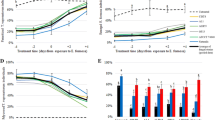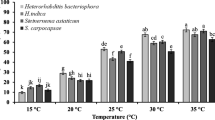Abstract
The aim of this study was to investigate under a controlled environment, the effect of temperature on the survival and infectivity of Pseudotheraptus devastans Distant, a cassava anthracnose disease vector. The insect P. devastans was collected from young cassava (Manihot esculenta Crantz) field plots, at the International Institute of Tropical Agriculture, (IITA), Ibadan, Nigeria. A mixture of the different developmental stages of eggs, first to fifth instar nymphs, and adults, were incubated in controlled environment chambers, under various constant temperatures of: 15, 17, 22, 25, 27, 30, and 35°C. Relative humidity at different temperature conditions were recorded and maintained at 90%, 85%, 80%, 75%, 70%, 65%, and 60%, respectively. A significant increase in insect survival was observed between 22 and 27°C temperature conditions while a significant decrease in survival was observed at 15°C and above 30°C. Lesion number, lesion diameter and infectivity among the insect stages varied as a function of temperature and relative humidity. Infectivity was highest at 22–25°C maintained at 75–80% RH and lowest at 15°C and above 30°C maintained respectively, at 65% RH and 90% RH. There was considerable low vector infectivity due to low survival of the insects at extreme temperatures.
Similar content being viewed by others
References
M Chadrasekharan-Nair MR Menon N Suharban AS Verma (1979) ArticleTitleAnthracnose of cassava: A new record in India Curr Sci 48 443
JC Lozano RH Booth (1974) ArticleTitleDiseases of cassava (Manihot esculenta Crantz) Pest Article News Summ (PANS) 20 30–54
Centro Internacional de Agricultura Tropical (CIAT). Cassava Program Annual Report, 1983: 68 pp.
Cock JC, Cassava. New Potential for a Neglected Crop. Boulder, Co: Westview Press Inc., 1985: 191 pp.
Nweke FI, Dixon AGO, Asiedu R, Falayan SA. Cassava varietal needs of farmers and the potential for production growth in Africa. COSCA (Collaborative study of cassava in Africa). Working paper No. 10, IITA Publication, 1994: 85 pp.
SH Hahn J Keyser (1985) ArticleTitleCassava: A basic food for Africa Outlook Agricult 14 IssueID2 95–100
InstitutionalAuthorNameFood and Agricultural Organization (FAO) (1993) Food Production Statistics FAO Rome, Italy 31
JC Lozano (1989) ArticleTitleOutbreak of cassava diseases and losses induced Fitopathol Bras 14 7–11
P Bruggen ParticleVan der PD Gregoire H Maraite (1987) ArticleTitleTemperature induced alteration in the expression of susceptibility of cassava to Colletotrichum gloeosporioides f.sp manihotis J Phytopathol 130 46–58
ES Brown (1955) ArticleTitlePseudotheraptus wayi. A new genus and species of Coreid (Hemiptera) injurious to coconut in East Africa Bull Entomol Res 46 IssueID1 221–240 Occurrence Handle10.1017/S0007485300030868
A Fataye G Detaffin (1989) ArticleTitleIntegrated control of Pseudotheraptus devastans and related species Oléagineux 44 525–530
International Institute of Tropical Agriculture (IITA). Integrated pest management for tropical root crops. In: Hahn SK, Caveness FE, eds. Proceedings of the Workshop on the Global Status and Prospects for Integrated Pest Management of Root and Tuber Crops in the Tropics, 25–30 October, 1987, Ibadan, Nigeria, 1987: 235.
D Mariau (1969) ArticleTitle Pseudotheraptus: un nouveau ravageur du cocotier en Afrique occidentale Oléagineux 24 IssueID1 21–25
GB Dennill MJ Erasmus (1992) ArticleTitleThe insect pests of avocado fruits-increasing pest complex and changing pest status J Entomol Soc Southern Africa 55 51–57
B Boher JF Danielle G Fabres G Bani (1983) ArticleTitleAction de Pseudotheraptus devastans (Dist.) et de Colletotrichum gloeosporioides Penz., dans le dévélopement des chancres et la chutte de feuilles chez le manioc Agronomie 3 989–994
JF Julia D Mariau (1978) ArticleTitleLa punaise du cocotier. Pseudotheraptus sp. en Côte-d’Ivoire. 1. Etudes préalables a la mise au point d’une méthode de lutte intégrée Oléagineux 33 65–75
C Makambila (1994) ArticleTitleL’interaction entre une punaise Pseudotheraptus devastans Dist et un champignon Colletotrichum gloeosporioides Penz. Sur l’installation de l’anthracnose sur les tiges de manioc Tropicultura 12 IssueID3 104–108
Muimba KA. Predisposition of cassava plants to infection by Colletotrichum manihotis. Henn, and some factors involved in the initiation of anthracnose disease. M.Phil thesis, University of Ibadan, Nigeria 1982: 242.
Dubois J, Mostade JM. La maladie des cierges du manioc provoqueé par Pseudotheraptus devastans Dist. Bulletin d’Information (INERA) Zaire 1973; Tome 1: 1–17.
N Lodos (1967) ArticleTitleContribution to the biology and damage caused by the cocoa coreid Pseudotheraptus devastans (Hemiptera-Coreidae) Ghana J Scie 7 IssueID3–4 87–102
Mayne M. Insectes et animaux attaquant le cacoyer au Congo Belge. Etude de la biologie agricole, No. 3. Ministeres de Colonies, Service Agricole. Royaunme de Belgiques 1971: 80.
InstitutionalAuthorNameIITA Cassava in Tropical Africa (1990) A Reference Manual IITA, Ibadan Nigeria 109
CN Fokunang CN Akem T Ikotun AGO Dixon EA Tembe (2000) ArticleTitleRole of the insect vector, Pseudotheraptus devastans, in cassava anthracnose disease development Eur J Plant Pathol 106 319–327 Occurrence Handle10.1023/A:1008757118385
C Makambila A Bakala-Koumouno (1982) ArticleTitleInoculation artificiel de tiges de manioc avec Colletotrichum manihotis Henn. Agron Trop 37 IssueID2 172–175
SK Hahn JG Isoba T Ikotun (1989) ArticleTitleResistant breeding in root and tuber crops at the International Institute of Tropical Agriculture Nigeria Crop Protect 35 147–168
RL Theberge (1992) Common African Pests and Diseases of Cassava, Yam, Sweet Potato and Cocoyam IITA Ibadan, Nigeria 107
Ikotun T, Hahn SK. Screening cassava cultivars for resistance to anthracnose disease. Tropical root crops in developing economy. In: Ofori F, Hahn SK eds. Proceedings of the Ninth Symposium of the International Society for Tropical Root Crops. 20–26 October, 1991, Accra, Ghana, 1992: 178–183.
JC Lozano D Byrne A Bellotti (1980) ArticleTitleCassava/ecosystem relationships and their influence on breeding strategy Trop Pest Manage 26 IssueID2 180–187 Occurrence Handle10.1080/09670878009414391
KA Mwimba ER Terry MO Adeniji (1987) ArticleTitleA disease-like injury on cassava caused by Pseudotheraptus devastans Dist (Heteroptera: Coreidae), Trop Pest Manage 33 IssueID1 35–38
CN Fokunang CN Akem T Ikotun AGO Dixon EA Tembe (2001) ArticleTitleCulture Morphological and pathogenic variability in Colletotrichum gloeosporioides f. sp. manihotis in cassava cultivars Pakistan J Biol Sci 3 713–716
Barnett HI, Hunter BB. Illustrated Genera of Imperfect Fungi. 3rd edn. Burgess Publishing Company, 1972: 209 pp.
OW Richard RG Davies (1957) A Textbook of Entomology Methuen and Co Limited London 429
InstitutionalAuthorNameSAS Institute (1989) SAS User’s Guide: Statistic, Version 5 SAS Inc Cary, NC 231
D Mariau (1993) ArticleTitleIntegrated control in palm plantations Oléagineux 48 309–318
G Rapp MS Salum (1995) ArticleTitleAnt fauna, pest damage and yield in relation to the density of weed in coconut sites in Zanzibar, Tanzania J Appl Entomol 119 45–48
A Douaho (1984) ArticleTitlePest and diseases of oil palm and coconut–biological control of Pseudotheraptus and related species Oleagineux 39 257–262
FMA Dupont GB Dennill (1996) ArticleTitleAn ecological study of the damage done to avocado fruits by citrus leafhopper Penthimiola bella (Cicadellidae) and coconut bug Pseudotheraptus wayi (Coreidae) in South Africa Int J Pest Manage 42 107–112 Occurrence Handle10.1080/09670879609371980
IC Onwueme (1978) The tropical tuber crops. Yams, Cassava, Sweet Potato and Cocoyams John Wiley and Sons NY, Toronto 234
M Sporleder G Rapp (1998) ArticleTitleThe effect of Oecophylla longinoda (Latr.) (HymFormicidae) on coconut palm productivity with respect to Pseudotheraptus wayi Brown (Hem. Coriedae) damage in Zanzibar J Appl Entomol 122 475–481
CN Fokunang CN Akem T Ikotun AGO Dixon (1999) ArticleTitleEffect of planting season on cassava anthracnose disease development Crop Protect 18 407–413
Author information
Authors and Affiliations
Corresponding author
Rights and permissions
About this article
Cite this article
Fokunang, C.N., Dixon, A.G.O. & Ikotun, T. Effect of temperature on the survival and infectivity of Pseudotheraptus devastans vector. Mycopathologia 158, 385–392 (2004). https://doi.org/10.1007/s11046-004-8667-z
Received:
Accepted:
Issue Date:
DOI: https://doi.org/10.1007/s11046-004-8667-z




